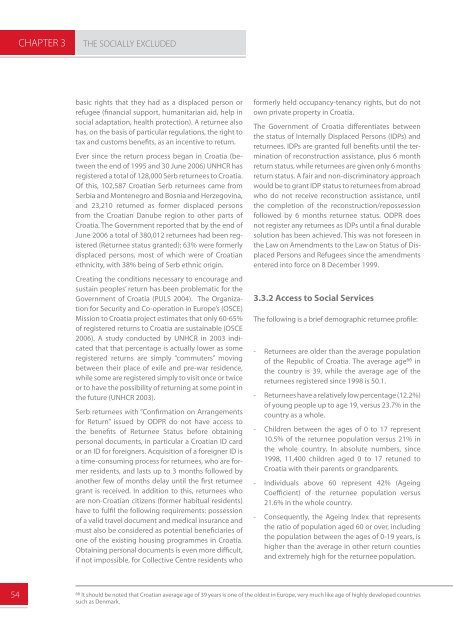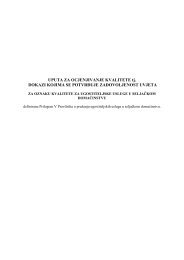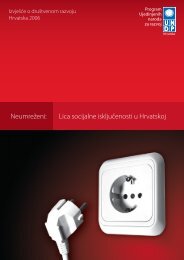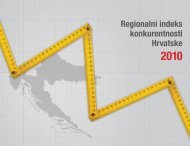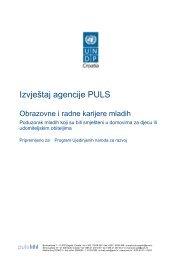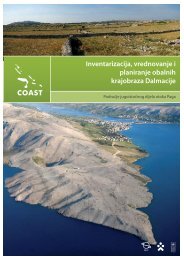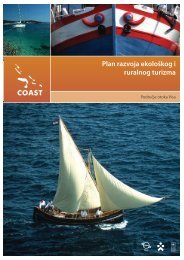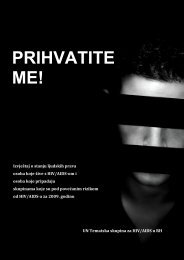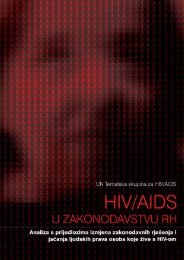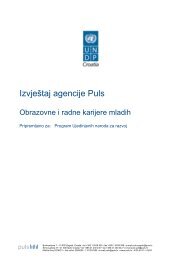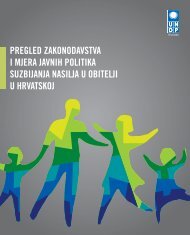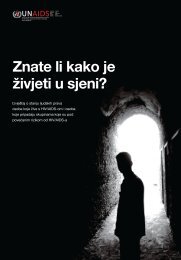WEB engleska verzija end.indd - UNDP Croatia
WEB engleska verzija end.indd - UNDP Croatia
WEB engleska verzija end.indd - UNDP Croatia
- No tags were found...
You also want an ePaper? Increase the reach of your titles
YUMPU automatically turns print PDFs into web optimized ePapers that Google loves.
CHAPTER 3THE SOCIALLY EXCLUDEDbasic rights that they had as a displaced person orrefugee (financial support, humanitarian aid, help insocial adaptation, health protection). A returnee alsohas, on the basis of particular regulations, the right totax and customs benefits, as an incentive to return.Ever since the return process began in <strong>Croatia</strong> (betweenthe <strong>end</strong> of 1995 and 30 June 2006) UNHCR hasregistered a total of 128,000 Serb returnees to <strong>Croatia</strong>.Of this, 102,587 <strong>Croatia</strong>n Serb returnees came fromSerbia and Montenegro and Bosnia and Herzegovina,and 23,210 returned as former displaced personsfrom the <strong>Croatia</strong>n Danube region to other parts of<strong>Croatia</strong>. The Government reported that by the <strong>end</strong> ofJune 2006 a total of 380,012 returnees had been registered(Returnee status granted); 63% were formerlydisplaced persons, most of which were of <strong>Croatia</strong>nethnicity, with 38% being of Serb ethnic origin.Creating the conditions necessary to encourage andsustain peoples’ return has been problematic for theGovernment of <strong>Croatia</strong> (PULS 2004). The Organizationfor Security and Co-operation in Europe’s (OSCE)Mission to <strong>Croatia</strong> project estimates that only 60-65%of registered returns to <strong>Croatia</strong> are sustainable (OSCE2006). A study conducted by UNHCR in 2003 indicatedthat that percentage is actually lower as someregistered returns are simply “commuters” movingbetween their place of exile and pre-war residence,while some are registered simply to visit once or twiceor to have the possibility of returning at some point inthe future (UNHCR 2003).Serb returnees with “Confirmation on Arrangementsfor Return” issued by ODPR do not have access tothe benefits of Returnee Status before obtainingpersonal documents, in particular a <strong>Croatia</strong>n ID cardor an ID for foreigners. Acquisition of a foreigner ID isa time-consuming process for returnees, who are formerresidents, and lasts up to 3 months followed byanother few of months delay until the first returneegrant is received. In addition to this, returnees whoare non-<strong>Croatia</strong>n citizens (former habitual residents)have to fulfil the following requirements: possessionof a valid travel document and medical insurance andmust also be considered as potential beneficiaries ofone of the existing housing programmes in <strong>Croatia</strong>.Obtaining personal documents is even more difficult,if not impossible, for Collective Centre residents whoformerly held occupancy-tenancy rights, but do notown private property in <strong>Croatia</strong>.The Government of <strong>Croatia</strong> differentiates betweenthe status of Internally Displaced Persons (IDPs) andreturnees. IDPs are granted full benefits until the terminationof reconstruction assistance, plus 6 monthreturn status, while returnees are given only 6 monthsreturn status. A fair and non-discriminatory approachwould be to grant IDP status to returnees from abroadwho do not receive reconstruction assistance, untilthe completion of the reconstruction/repossessionfollowed by 6 months returnee status. ODPR doesnot register any returnees as IDPs until a final durablesolution has been achieved. This was not foreseen inthe Law on Am<strong>end</strong>ments to the Law on Status of DisplacedPersons and Refugees since the am<strong>end</strong>mentsentered into force on 8 December 1999.3.3.2 Access to Social ServicesThe following is a brief demographic returnee profile:- Returnees are older than the average populationof the Republic of <strong>Croatia</strong>. The average age 66 inthe country is 39, while the average age of thereturnees registered since 1998 is 50.1.- Returnees have a relatively low percentage (12.2%)of young people up to age 19, versus 23.7% in thecountry as a whole.- Children between the ages of 0 to 17 represent10.5% of the returnee population versus 21% inthe whole country. In absolute numbers, since1998, 11,400 children aged 0 to 17 retuned to<strong>Croatia</strong> with their parents or grandparents.- Individuals above 60 represent 42% (AgeingCoefficient) of the returnee population versus21.6% in the whole country.- Consequently, the Ageing Index that representsthe ratio of population aged 60 or over, includingthe population between the ages of 0-19 years, ishigher than the average in other return countiesand extremely high for the returnee population.5466 It should be noted that <strong>Croatia</strong>n average age of 39 years is one of the oldest in Europe, very much like age of highly developed countriessuch as Denmark.


